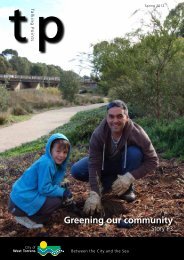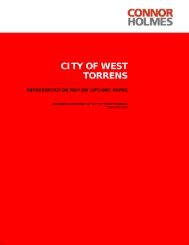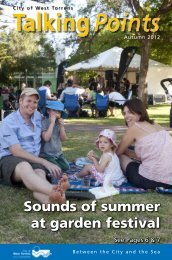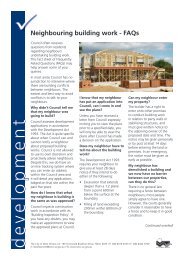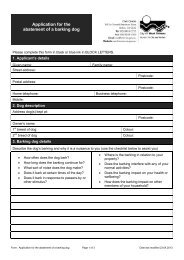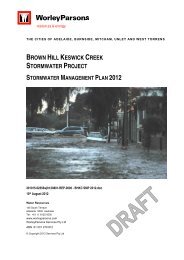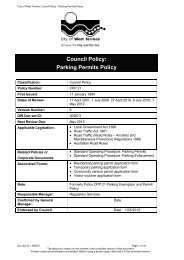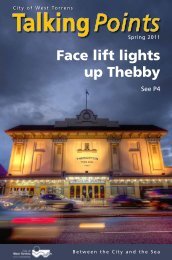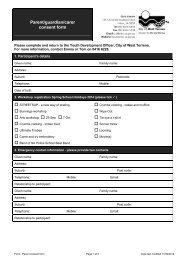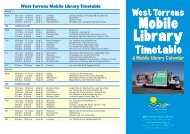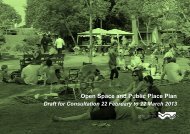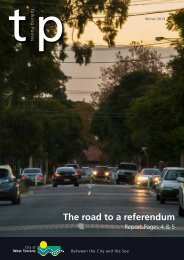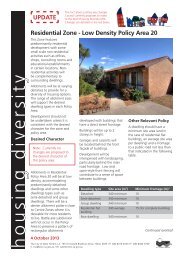Recommendations - City of West Torrens - SA.Gov.au
Recommendations - City of West Torrens - SA.Gov.au
Recommendations - City of West Torrens - SA.Gov.au
Create successful ePaper yourself
Turn your PDF publications into a flip-book with our unique Google optimized e-Paper software.
‘ Transport is critically<br />
important to the social,<br />
cultural and economic<br />
success <strong>of</strong> every Australian<br />
community.’<br />
There are a number <strong>of</strong> strategic plans<br />
and polices developed by the State<br />
<strong>Gov</strong>ernment with reference to the<br />
transport issues.<br />
Some <strong>of</strong> the key points <strong>of</strong> these<br />
strategies are summarised below.<br />
5.1 Federal Framework<br />
5.1.1 Local <strong>Gov</strong>ernment Roads and<br />
Transport Strategy 2006-2016 ALGA<br />
The Strategy acknowledges that<br />
transport is critically important to the<br />
social, cultural and economic success<br />
<strong>of</strong> every Australian community. The<br />
Strategy calls for forging transport<br />
partnerships between Federal and<br />
Local <strong>Gov</strong>ernments to deliver efficient,<br />
effective and equitable transport<br />
services and infrastructure, through<br />
the following key areas:<br />
• local road funding and management<br />
• urban transport solutions<br />
• mobility and access for regional<br />
Australians<br />
• freight management<br />
• long-term sustainability <strong>of</strong> local<br />
government.<br />
5.2 State Framework<br />
5.2.1 Draft Planning Strategy<br />
for Metropolitan Adelaide<br />
Growing Prosperity<br />
Land use and transport integration –<br />
character <strong>of</strong> transport routes;<br />
22<br />
Part 1 - Overview | Other Policy Framework<br />
access to public transport; equitable<br />
access to employment opportunities,<br />
service and facilities; a sustainable<br />
transport system that is integrated,<br />
coordinated, affordable, efficient and<br />
safe; importance <strong>of</strong> airports.<br />
Employment and business<br />
focus areas – planned employment<br />
areas across a range <strong>of</strong> industries<br />
with supporting infrastructure;<br />
export growth an important driver <strong>of</strong><br />
economic prosperity; access routes;<br />
opportunities for education and<br />
training; benefit<br />
<strong>of</strong> cluster.<br />
Industry – focus on export growth;<br />
ensure the appropriate supply <strong>of</strong><br />
serviced industrial land; industry<br />
clusters to warrant improved physical<br />
infrastructure and facilitate move<br />
towards more sustainable production<br />
processes; minimise interface issues.<br />
Commercial uses – preferably located<br />
within designated activity centres;<br />
functional and attractive commercial<br />
uses; safe traffic access.<br />
Tourism facilities – enhance tourism<br />
appeal; enhance connections between<br />
tourism assets, ready access for all; key<br />
gateway points eg Adelaide Airport<br />
and passenger routes; preserve history<br />
and heritage.<br />
Energy efficiency – energy-efficient<br />
design and layout <strong>of</strong> land and<br />
buildings; reducing the amount <strong>of</strong><br />
energy used for transport, eg promote<br />
walking and cycling.<br />
Building communities<br />
Activity centres – contain retail<br />
and commercial uses traditionally<br />
found in centres as well as a diverse<br />
range <strong>of</strong> other uses, including<br />
community facilities, <strong>of</strong>fices and<br />
residential development; play a key<br />
role in providing goods and services,<br />
employment and a cultural focus for<br />
the community; encouraging a mix <strong>of</strong><br />
uses; encouraging walking, cycling and<br />
the use <strong>of</strong> public transport; creating<br />
attractive, functional and vibrant<br />
activity centres.<br />
5.2.2 Strategic Infrastructure Plan<br />
for South Australia<br />
Invest in transport infrastructure<br />
• Develop and deepen Outer<br />
Harbour and substantially improve<br />
infrastructure at the port <strong>of</strong> Adelaide.<br />
• Improve the north-south transport<br />
corridor.<br />
• Develop and maintain regional<br />
freight networks.<br />
• Increase use <strong>of</strong> public transport.<br />
• Other major infrastructure works<br />
announced by the <strong>Gov</strong>ernment<br />
include the creation <strong>of</strong> a non-stop<br />
north-south corridor between the<br />
Southern Expressway and the Port<br />
River Expressway, public transport<br />
upgrades and the extension <strong>of</strong> the<br />
tram service from North Terrace<br />
to the Entertainment Centre and<br />
beyond.<br />
5.2.3 Adelaide Airport Limited<br />
Master Plan<br />
See Section 6.6<br />
5.2.4 Metropolitan Local<br />
<strong>Gov</strong>ernment Transport Strategy<br />
August 2005<br />
The Metropolitan Local <strong>Gov</strong>ernment<br />
Group (MLGG) provides a forum for<br />
metropolitan councils to develop<br />
decisions and progress actions through



